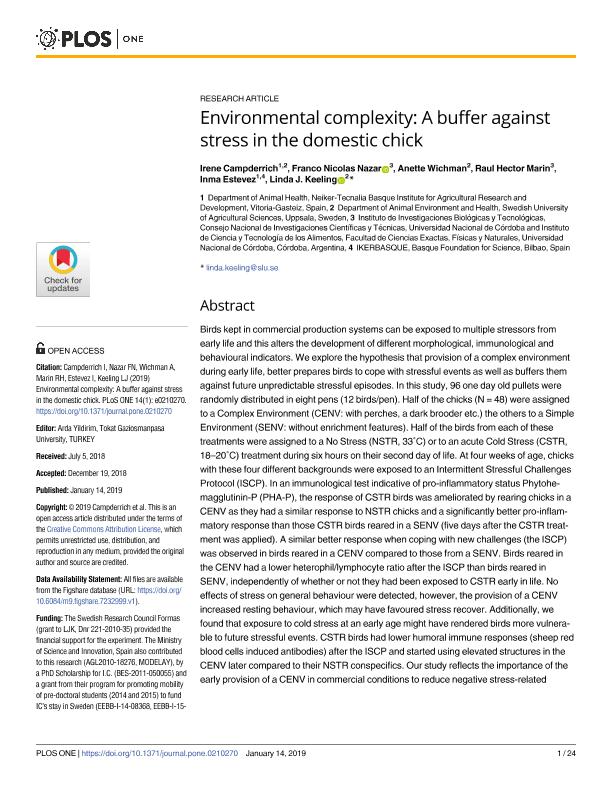Artículo
Environmental complexity: A buffer against stress in the domestic chick
Campderrich, Irene; Nazar, Franco Nicolas ; Wichman, Anette; Marin, Raul Hector
; Wichman, Anette; Marin, Raul Hector ; Estevez, Inma; Keeling, Linda J.
; Estevez, Inma; Keeling, Linda J.
 ; Wichman, Anette; Marin, Raul Hector
; Wichman, Anette; Marin, Raul Hector ; Estevez, Inma; Keeling, Linda J.
; Estevez, Inma; Keeling, Linda J.
Fecha de publicación:
01/2019
Editorial:
Public Library of Science
Revista:
Plos One
e-ISSN:
1932-6203
Idioma:
Inglés
Tipo de recurso:
Artículo publicado
Clasificación temática:
Resumen
Birds kept in commercial production systems can be exposed to multiple stressors from early life and this alters the development of different morphological, immunological and behavioural indicators. We explore the hypothesis that provision of a complex environment during early life, better prepares birds to cope with stressful events as well as buffers them against future unpredictable stressful episodes. In this study, 96 one day old pullets were randomly distributed in eight pens (12 birds/pen). Half of the chicks (N = 48) were assigned to a Complex Environment (CENV: with perches, a dark brooder etc.) the others to a Simple Environment (SENV: without enrichment features). Half of the birds from each of these treatments were assigned to a No Stress (NSTR, 33C) or to an acute Cold Stress (CSTR, 18–20C) treatment during six hours on their second day of life. At four weeks of age, chicks with these four different backgrounds were exposed to an Intermittent Stressful Challenges Protocol (ISCP). In an immunological test indicative of pro-inflammatory status Phytohe-magglutinin-P (PHA-P), the response of CSTR birds was ameliorated by rearing chicks in a CENV as they had a similar response to NSTR chicks and a significantly better pro-inflammatory response than those CSTR birds reared in a SENV (five days after the CSTR treatment was applied). A similar better response when coping with new challenges (the ISCP) was observed in birds reared in a CENV compared to those from a SENV. Birds reared in the CENV had a lower heterophil/lymphocyte ratio after the ISCP than birds reared in SENV, independently of whether or not they had been exposed to CSTR early in life. No effects of stress on general behaviour were detected, however, the provision of a CENV increased resting behaviour, which may have favoured stress recover. Additionally, we found that exposure to cold stress at an early age might have rendered birds more vulnerable to future stressful events. CSTR birds had lower humoral immune responses (sheep red blood cells induced antibodies) after the ISCP and started using elevated structures in the CENV later compared to their NSTR conspecifics. Our study reflects the importance of the early provision of a CENV in commercial conditions to reduce negative stress-related effects. Within the context of the theory of adaptive plasticity, our results suggest that the early experience of the birds had long lasting effects on the modulation of their phenotypes.
Palabras clave:
STRESS
,
DOMESTIC CHICKS
,
COLD
,
IMMUNE SYSTEM
Archivos asociados
Licencia
Identificadores
Colecciones
Articulos(IIBYT)
Articulos de INSTITUTO DE INVESTIGACIONES BIOLOGICAS Y TECNOLOGICAS
Articulos de INSTITUTO DE INVESTIGACIONES BIOLOGICAS Y TECNOLOGICAS
Citación
Campderrich, Irene; Nazar, Franco Nicolas; Wichman, Anette; Marin, Raul Hector; Estevez, Inma; et al.; Environmental complexity: A buffer against stress in the domestic chick; Public Library of Science; Plos One; 14; 1; 1-2019
Compartir
Altmétricas



